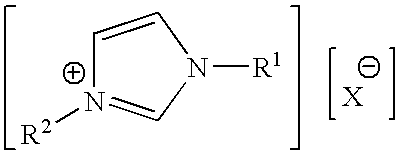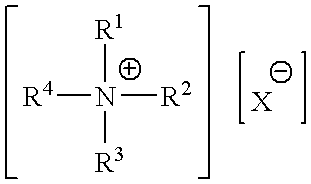Extracting biopolymers from a biomass using ionic liquids
- Summary
- Abstract
- Description
- Claims
- Application Information
AI Technical Summary
Problems solved by technology
Method used
Image
Examples
example 1
Polyhydroxyalkanoate (PHA) Dissolution
[0054]0.12 grams of PHA, a poly(hydroxybutyrate / hydroxyhexanoate) copolymer containing about 6 mol % hexanoate, is added to a glass vial containing 2 g of Terrasail® (available from Sachem, Inc.), which is a liquid at room temperature. The temperature of the vial is maintained at 115° C. for 3 minutes. The vial is agitated to enhance dissolution. A viscous, visually clear solution of polyhydroxyalkanoate in the ionic liquid is obtained.
example 2
Keratin Dissolution and Recovery
[0055]Keratin (0.48 g) is added to a glass vial containing 3 g of 1-ethyl-3-methylimidazolium acetate (available from BASF), which is a liquid at room temperature. The temperature of the vial is maintained at 95° C. for 10 minutes in an oil bath. The vial is agitated to facilitate dissolution. A viscous, visually clear solution of keratin in the ionic liquid is obtained. The keratin-ionic liquid solution is poured into 150 mL of water. The pH of the mixture is then adjusted to pH 4.5 using 1N HCl; keratin precipitates from the mixture resulting in a cloudy solution. The resulting solution is filtered to recover the precipitated keratin.
example 3
Extraction of PHA From a Biomass
[0056]60 g of a biomass, made via fermentation process using genetically engineered organism sample, containing a PHA, poly(3-hydroxybutyrate-co-3-hydroxyhexanoate) as an admission that it is prior art with respect to the present invention. To the extent that any meaning or definition of a term in this written document conflicts with any meaning or definition of the term in a document incorporated by reference, the meaning or definition assigned to the term in this written document shall govern.
PUM
| Property | Measurement | Unit |
|---|---|---|
| temperatures | aaaaa | aaaaa |
| melting temperature | aaaaa | aaaaa |
| melting temperature | aaaaa | aaaaa |
Abstract
Description
Claims
Application Information
 Login to View More
Login to View More - R&D
- Intellectual Property
- Life Sciences
- Materials
- Tech Scout
- Unparalleled Data Quality
- Higher Quality Content
- 60% Fewer Hallucinations
Browse by: Latest US Patents, China's latest patents, Technical Efficacy Thesaurus, Application Domain, Technology Topic, Popular Technical Reports.
© 2025 PatSnap. All rights reserved.Legal|Privacy policy|Modern Slavery Act Transparency Statement|Sitemap|About US| Contact US: help@patsnap.com



